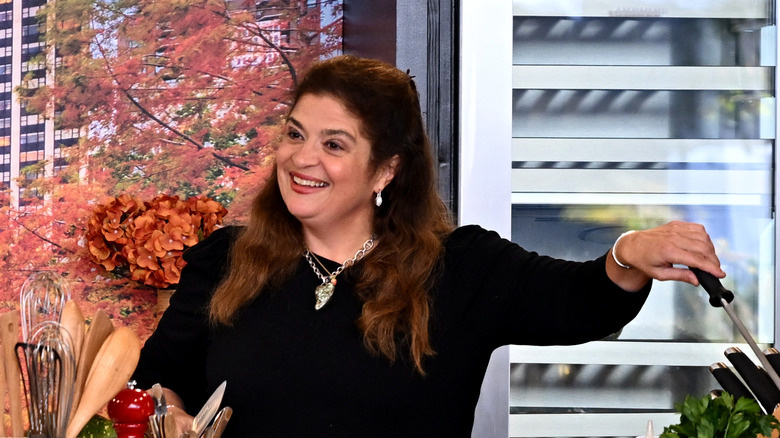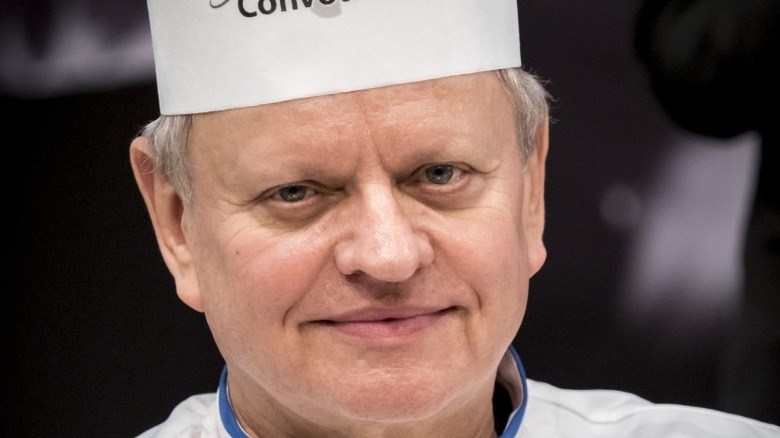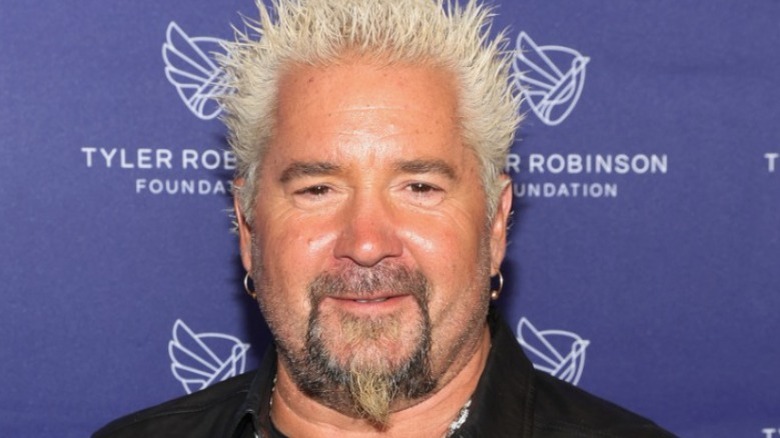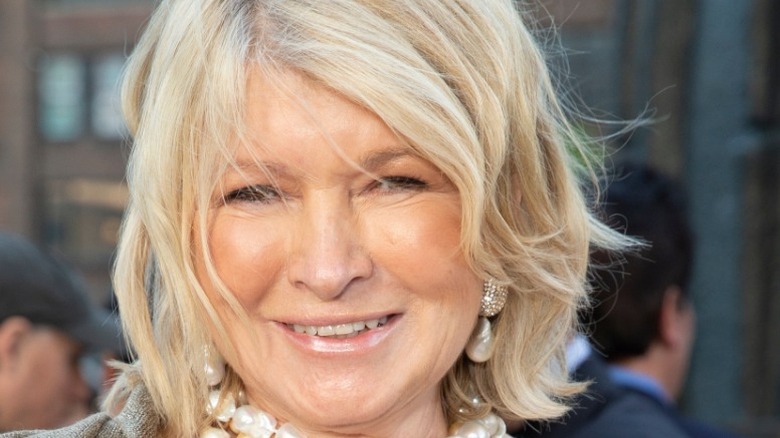14 Tips From Celebrity Chefs For All Your Potato Needs
Potatoes have long been a go-to food for many of us, whether as a simple comfort or as an affordable way to get carbohydrates into your meals. And some of us just love them, too. What's not to love? They're easy to prepare and can be used in so many ways for every meal of the day. But even something so ubiquitous can still be loaded with questions, from which type you should use to recommendations for something new, like these over-the-top amazing pommes anna.
We turned to some of our favorite celebrity chefs to find out everything you could possibly need to know about perfecting your potato repertoire. We came up with loads of ways to make creamier mashed, crispier roasted, fluffier baked, and even ways to add loads of luxury to this humble root vegetable. Americans eat about 124 pounds of them a year, according to the Idaho Potato Museum, so there's not much chance that you don't already have a few favorite ways to serve these glorious tubers. Read on to see what your favorite celebrity chef had to say about how they make potatoes easy and exceptional.
Michael Symon uses a ricer for smoother mashed potatoes
Try out these simple tips from Michael Symon for mashed potatoes with the most unbeatably fluffy texture ever. First, always start your potatoes in cold water so they get cooked evenly. Then, make sure to use lots of salt in the water in order to get your spuds seasoned all the way through. But, more importantly, how you mash those potatoes matters even more.
Instead of using a masher, pull out your ricer. It stands to reason that the item that makes perfectly velvety gnocchi will do the same for plain potatoes. Just pass them through once, and add a load of butter. Symon doesn't recommend using milk, preferring instead to use butter — lots of butter (he uses 50% butter for the amount of potato). You can melt the butter before whipping it into the potatoes, to prevent them from getting cold. He also cautions against ever using electric beaters or a stand mixer to mix your potatoes. They're just too powerful and will over-whip your spuds, leading to gumminess and disappointment. Symon finishes his mash with salt and a touch of nutmeg before serving.
Use a slightly waxy potato for Gordon Ramsay's fondant potatoes
Gordon Ramsay has the skills to back-up his celebrity chef status, especially when it comes to French cooking techniques, like fondant potatoes. Have you heard of this ultra-buttery dish? These potatoes have that creamy interior and crunchy exterior that we all clamor for. The creaminess comes from the cooking technique and loads of fat.
Ramsay's biggest tip for superb fondant potatoes is choosing the right potato, like a King Edward potato. Speciality Produce describes them as having firm and dense flesh with a fluffy yet floury texture. Desirée potatoes can also be used, but if you're at a loss for either of those, Yukon Golds will do in a pinch. Fondant potatoes are barrel-shaped (like thick scallops) and for good reason — all those sides will increase the surface area for crispiness. A good sear to start and bathing them in a gelatin-rich stock during cooking is the secret to these beauties. Ramsay doesn't use butter until finishing (because it will just burn) but doesn't think you can get away with none. Fat is the key to tender spuds here.
Ina Garten uses olive oil for crispy-skinned baked potatoes
As far as celeb chefs go, The Barefoot Contessa has to be one of the originals, so trust us when we say that she knows her stuff. Her previous recommendation of adding lemon to puréed potatoes might sound strange, but when tempered with a decent amount of butter, the results are magical. One of our favorite Barefoot Contessa potato hacks isn't for mashed, however. Again, Garten relies on a pinch of lemon zest to give her baked potatoes a crispy skin and unbeatable flavor.
Her recipe manages to attain a flavorful, crusty skin on baked potatoes that makes them unforgettable. And it takes little more than a decent coating of olive oil and a quick roll in a salty herb mixture. By zipping rosemary, thyme, lemon zest, and fleur de sel (or sea salt) through a food processor, you end up with a flavor boost that's wildly easy to use and gives your potatoes the perfect finish. And if you want to go a step further, Garten makes a whipped feta, cream cheese, and lemon topping to finish off these beauties.
Par cooking before roasting is the trick to Molly Yeh's incredible potatoes
These next two tips work in tandem to give you the absolute best roasted potatoes you might ever eat. Molly Yeh might not be an actual chef, but she does have an enormous following as a food blogger and cookbook author, so go with us here. Roasted potatoes are a big deal in some families, and soggy or overly toothy just won't do. We can help.
Yeh's hack takes a two-step approach for perfect roasted potatoes, starting with par-boiling. This ensures that the potatoes are cooked through but, more importantly, it works because of simple science. After you drain those boiled cubes, the starch (potatoes are full of starch, remember) dries on the exterior. It's important to give the taters a minute to breathe and dry in the colander before tossing them into the oven. The few minutes where they're allowed to dry is the secret to their crispness. Once dry, toss them with a good fat (try duck or bacon fat if you're feeling extra) and whatever spices you like. Roast at 450 F until done.
Rough potatoes are the secret to Jamie Oliver's crispy roast potatoes
To piggyback on the previous tip, here's a little extra roasted potato wisdom from the Naked Chef, Jamie Oliver. He knows his roast potatoes, as they're an integral part of Sunday lunch, according to the British Council, and you don't want to mess with that.
Oliver agrees with the tip from Molly Yeh, but he adds a little more knowledge. Oliver recommends using a lot of salt in the par-boiling step, just like Michael Symon. Oliver likes to cook them until they're awfully close to being cooked through. They still need some structure though; make sure not to overcook them, otherwise, you're just making mashed potatoes. After that, the secret to getting your roasted potatoes crispy and delicious is roughing them up. It's not as difficult or aggressive as it sounds. After draining and letting them sit in the colander for a minute (to dry), give those spuds a quick shake to rough up the outside. A rougher exterior will cook up crispier because of all the craggy edges that will hang on to the oil you've coated them with.
Alex Guarnaschelli uses root veggies to amp up her mashed potatoes
Not into 100% potato bliss? We have a solution for you. Celeb chef Alex Guarnaschelli has a solution that includes adding other veggies to incorporate more vitamins easily — or sneakily, depending on your feeding situation. Get into the habit of adding other, less starchy veg into your mash and increasing your vegetable intake. Stick with other root vegetables if you want a truly imperceptible addition.
Guarnaschelli turns to turnips, cauliflower, or sunchokes (sunchokes might be one of the unique vegetables that you've never heard of... but should). All work exceptionally well in this instance. Boil it all up the way you do with taters, mash it up, and flavor it with butter and herbs in the same way you ordinarily would. She also replaces a portion of sweet potato with rutabaga in her sweet potato casserole, as a way to incorporate more nutrients in one of her best cooking tips. However, Guarnaschelli cautions against using anything stringy as an addition, because it will give you away immediately — we're looking at you asparagus and celery.
Bobby Flay relies on créme frâiche for his ultra creamy mashed potatoes
Bobby Flay, who you might think of as the king of burgers, also has some insight into the perfect mashed potato. You might not be surprised to find out that it's about dairy... but at least it's an upgraded form of dairy. Flay has an All-American vibe, but he's also a graduate of the International Culinary Center in New York City (formerly called The French Culinary Institute), making him more than just a celebrity who slings terrific burgers.
So it's no surprise to find out that his add-in of choice is crème fraîche, France's answer to sour cream. Crème fraîche is a little more subtle and nuanced, as well as more resistant to heat, so it won't curdle as sour cream can. And it's pretty easy to make at home if you've got a reliable recipe. Flay uses it as his secret ingredient to make his mashed potatoes as creamy and flavorful as possible. He still incorporates butter, but the créme frâiche gives the dish unmistakable tanginess and depth. Added right before serving, after butter and milk, it also adds a creamy thickness that can't be copied.
Alton Brown is convinced triangle cut potatoes cook better
Knife skills are important no matter what you're up to in the kitchen. And while it might seem like dicing up a pile of taters isn't the most important time to get chopping like a pro, there are some benefits. First of all, it comes down to the evenness of those chunks. The last thing you want is super creamy potatoes combined with uncooked bits, right? The more consistent you are with your cutting, the more consistent your cooking will be.
Alton Brown takes it a step further and cuts his potatoes into triangles before boiling them to ensure proper cooking. When slicing and dicing, Brown first peels his potatoes before cutting them into half-inch slices and stacking them three or four slices high. Now, this is where his scientific approach kicks in. By slicing the stack in half, turning it, and slicing it in half again, Brown asserts that these triangle-shaped spuds will cook perfectly for mashing. This comes down to the amount of surface area in contact with the boiling water... but we're here for the food, not the science, right?
Chef Joel Robuchon thinks that more butter is better for mashed potatoes
Much like Michael Symon, Chef Robuchon's tip relies on a massive amount of butter for the famous purée de pomme served at his restaurants around the world. And these are famous potatoes, indeed. Featured in the Michelin Guide, Robuchon calls them his signature dish and goes so far as to state that they're the reason for his success. Made with a 2-to-1 ratio of potato to butter, we'd say they're unforgettable, for sure.
Made with only potatoes, butter, milk, and salt, the dish is truly luxurious so don't expect your run-of-the-mill mashed. Robuchon's recipe calls for a floury and fluffy potato, like a Yukon Gold or a russet. Stay away from anything waxy (fingerlings or new potatoes) as they just won't give you the texture you desire here. The recipe also calls for the potatoes to be boiled with the skins on and then peeling them once they've cooled enough to handle. Purée the potatoes (run them through a food mill, ideally) rather than just roughly mashing them — these potatoes are silky smooth even before all that lush butter is added.
Anne Burrell adds celery root to potatoes for added flavor
If you're not familiar with celery root (or celeriac), then this tip might not appeal to you, but Chef Anne Burrell has been adding it to her mashed potatoes for years. In North America, it's called celery root and is often shaved into salads or cooked and mashed. Related to celery, it has a refreshing taste reminiscent of both celery and parsley.
When added to other mashed vegetables, it adds a subtle flavor, but it also adds a few important nutrients that potatoes, in particular, just don't have. As well, celery root is a non-starchy vegetable with tons of dietary fiber so it is also a boon to those looking to lower their carb intake. Burrell takes advantage of celery root's versatility by preparing it just like the potatoes she adds it to, by peeling and boiling. Celeriac does have a pretty tough, thick skin so if this is your first crack at it, buy a bigger one than you think you'll need. It will be easier to handle and you'll have enough to add to your dish.
Gordon Ramsay uses waxy potatoes for perfect hash browns at home
So far, we've been recommending floury potatoes for most of these recipes, and you must be wondering what to do with that bag of waxy spuds you've got. Thankfully, Gordon Ramsay has the answer. Waxy potatoes (such as fingerlings and red or blue-skinned ones) hold their shape much better, ensuring that your homemade hash browns don't get gooey.
Ramsay also has another tip for making restaurant-quality hash browns that also has a lot to do with the moisture of those spuds. After grating your potatoes (he also recommends grating up a little onion, too), mix all your ingredients together — potatoes, onion, salt, and seasoning — drop it into a strainer and squeeze out as much excess moisture as possible. Again, this is also something easier done with waxy potatoes, another reason they're a good choice here. Finally, shape the mixture and fry them in a very hot pan. Ramsay adds a little butter while they're cooking, just for a final bit of flavor and crispness. He also recommends using your spatula to press the hash browns, ensuring that everything sticks together.
Wasabi powder gives Guy Fieri's potatoes a bit of kick
Here's an upgrade to your mashed potatoes that you might need some convincing to try, but trust us, it's earned Guy Fieri rave reviews so far. Wasabi might be an unexpected ingredient in your mashed spuds but, apparently, it works incredibly well. The addition of 4 tablespoons of straight wasabi powder seems like a lot, but when you factor in all the other ingredients, especially all that butter and cream, the heat gets tempered enough to be enjoyable rather than overpowering. The recipe also includes a full head of roasted garlic, so these aren't your typical potatoes.
The flamboyant Fieri is known for being a permanent resident of "Flavortown," so the addition of wasabi shouldn't be all that surprising. Flavor purists might want to forego this one, but if you're itching to try something different, these might be the spuds for you. True Japanese wasabi can be hard to find, but we're quite sure that whatever you can get your hands on for this recipe will work just fine. Can't find the spicy condiment at all? We have some recommendations for wasabi substitutions, too.
Martha Stewart encourages smashing baked potatoes before serving
While not an actual chef, Martha Stewart definitely knows how to cook and has built an empire out of her food and entertaining knowledge, so we're including her. And her ultimate potato hack is just so easy that we couldn't resist. By smashing her fresh-out-of-the-oven baked potato against the counter, she immediately has a fluffy interior just waiting to be smothered in butter.
The science behind this is simple, really. Stewart bakes up a few russets, which are her pick for perfect baked potatoes. They're also our choice for one of the absolute best baking potatoes. High in starch and low in moisture, russets come out of the oven fluffy while their thick skins crisp up and stay sturdy enough to support loads of toppings. Stewart's added step of slicing open and smashing just helps to break up the interior, making it even fluffier than it already was. While not an extraordinary a-ha moment, it's still easy and very effective. Top your tater any way you like (she uses butter, crème fraîche, and caviar), and revel in your new-found potato prowess.
Tyler Florence boils potatoes in milk for the ultimate mash
Finally, Tyler Florence has a hack that he swears by for creating the most luxurious mash possible. It doesn't require any special equipment or exotic ingredients, either. While a few other chefs on this list rely on a lot of dairy to make their potatoes stand out, Florence uses a technique that takes advantage of cream right from the beginning. By boiling his potatoes in a combination of 2 cups of whole milk and two cups of heavy cream, the end product is unbelievably rich and, well, just as creamy as you'd imagine.
Florence's luxe touch might sound a little over the top, waste-wise, but part of the recipe does include folding some of that dairy back in after you finish mashing the boiled spuds. For the same reason you save pasta water to thicken your sauce, the starch-heavy cream will help to bring a lovely texture to your potatoes. As well, this technique works well for flavoring your dish, because herbs or cloves of garlic can be added to the boiling whole milk to imbue everything with extra seasoning.














